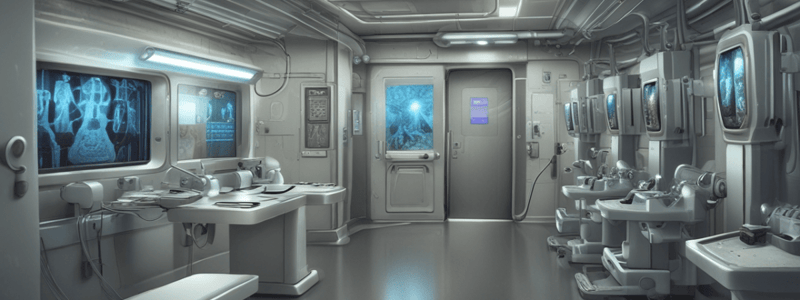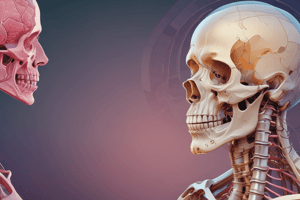Podcast
Questions and Answers
What is the term used to describe the movement of the imaging plate through the reader?
What is the term used to describe the movement of the imaging plate through the reader?
- Rotation
- Reflection
- Translation (correct)
- Deflection
What is the function of the special optics in the reader?
What is the function of the special optics in the reader?
- To deflect the laser beam
- To shape the laser beam (correct)
- To amplify the laser beam
- To reflect the laser beam
What is the purpose of the mirrors in the reader?
What is the purpose of the mirrors in the reader?
- To shape the laser beam
- To deflect the laser beam
- To amplify the laser beam
- To ensure consistent beam positioning (correct)
What directs the released phosphor energy to the photodetector?
What directs the released phosphor energy to the photodetector?
What is a region of interest used for in image recognition phase?
What is a region of interest used for in image recognition phase?
Why is it necessary to erase the image from the imaging plate?
Why is it necessary to erase the image from the imaging plate?
What is the purpose of histogram formation in the image recognition phase?
What is the purpose of histogram formation in the image recognition phase?
What is the result of cracks in the imaging plate on the processed image?
What is the result of cracks in the imaging plate on the processed image?
What is the purpose of the image recognition phase?
What is the purpose of the image recognition phase?
How often should the imaging plates be run through an erase cycle?
How often should the imaging plates be run through an erase cycle?
What happens to the electrons on the imaging plate during the reading process?
What happens to the electrons on the imaging plate during the reading process?
What is an artifact?
What is an artifact?
What is the purpose of the quality control (QC) station in the image processing workflow?
- To erase the imaging plate.
- To verify the image quality and accuracy.
- To review and manipulate the image.
- To store the image in the PACS system.
What is the purpose of the quality control (QC) station in the image processing workflow?
- To erase the imaging plate.
- To verify the image quality and accuracy.
- To review and manipulate the image.
- To store the image in the PACS system.
What is the result of operator errors in digital systems?
What is the result of operator errors in digital systems?
Why is it important to select the correct body part before exposure?
Why is it important to select the correct body part before exposure?
What is the primary purpose of collimation in radiography?
What is the primary purpose of collimation in radiography?
What is the result of proper collimation on patient dose?
What is the result of proper collimation on patient dose?
What is the purpose of shuttering in digital image processing?
What is the purpose of shuttering in digital image processing?
Why is it recommended to use conventional lead markers in digital image processing?
Why is it recommended to use conventional lead markers in digital image processing?
What is the primary benefit of using collimation during image acquisition?
What is the primary benefit of using collimation during image acquisition?
What is the purpose of marking the patient examination with lead positioning markers at the time of exposure?
What is the purpose of marking the patient examination with lead positioning markers at the time of exposure?
What is the benefit of using collimation in terms of scatter reduction?
What is the benefit of using collimation in terms of scatter reduction?
What is the result of proper preexposure collimation on image quality?
What is the result of proper preexposure collimation on image quality?
What is the primary reason for the occurrence of the moiré artifact in a stationary grid?
What is the primary reason for the occurrence of the moiré artifact in a stationary grid?
What can cause fine white lines to appear on a printed image?
What can cause fine white lines to appear on a printed image?
What is the primary reason for removing clothing and accessories during an imaging procedure?
What is the primary reason for removing clothing and accessories during an imaging procedure?
What can cause quantum mottle in an image?
What can cause quantum mottle in an image?
What should be done to prevent the moiré artifact in a stationary grid?
What should be done to prevent the moiré artifact in a stationary grid?
Study Notes
Imaging Plate Reader
- The imaging plate moves through or remains stationary in the reader, and the laser scans across the imaging plate multiple times, producing lines of light intensity information that are detected by a photodetector.
- The plate movement through the scanner is known as translation because it moves in a parallel manner at a certain rate through the reader.
- The translation speed of the plate must be coordinated with the scan direction of the laser, or the spacing of the scan lines will be affected.
Laser Beam and Optics
- The action of moving the laser beam across the imaging plate is similar to holding a flashlight at the same height and moving it back and forth across a wall.
- The more angled the beam is, the more elliptical the shape of the beam.
- To correct the change in beam shape, special optics keep the beam size, shape, and speed largely independent of the beam position.
- A beam deflector moves the laser beam rapidly back and forth across the imaging plate to stimulate the phosphors.
Erasing the Image
- The process of reading the image returns most but not all of the electrons to a lower energy state, effectively removing the image from the plate.
- Imaging plates are extremely sensitive to scatter radiation and should be erased to prevent a buildup of background signal.
- At least once a week, the plates should be run through an erase cycle to remove background radiation and scatter.
Preprocessing, Processing, and Forwarding the Image
- Once the imaging plate has been read, the signal is sent to the computer where it is preprocessed.
- The data then go to a monitor where the technologist can review the image, manipulate it if necessary, and send it to the quality control station and ultimately to the picture archiving and communication system (PACS).
Exposure
- Part selection depends on the type of system being used, and the technologist will choose the body part imaged either prior to exposure of the image receptor or after exposure.
- Always check to make sure the appropriate part has been selected.
- Collimation reduces the area of irradiation and the volume of tissue in which scatter can be created, resulting in increased contrast resolution.
- Postexposure image manipulation known as shuttering can add a black background around the original collimation edges, virtually eliminating the distracting white or clear areas.
Side/Position Markers
- Marking the patient examination at the time of exposure not only identifies the patient's side but also identifies the technologist performing the examination.
- This is also an issue of legality, as the images that include the technologist's markers allow the possibility of technologist testimony and lend credibility to their expertise.
Image Data Recognition and Preprocessing
- The image recognition phase is extremely important in establishing the parameters that determine collimation borders and edges, and histogram formation.
- A histogram is a graphic representation of the numerical tone values of an X-ray exposure.
- Each vendor has a specific tool for different situations such as neck, breasts, pediatrics, and hips in which the anatomy requires special recognition.
Artifacts
- Artifacts are any undesirable densities on the processed image other than those caused by scatter radiation or fog.
- There are four common types of artifacts: imaging plate artifacts, plate reader artifacts, image processing artifacts, and printer artifacts.
- Imaging plate artifacts can occur due to cracks in the imaging plate, which appear as areas of radiolucency on the image.
- The orientation of a stationary grid relative to the direction of the laser scan is critical to reduce the likelihood of the moiré artifact.
- Printer artifacts can occur due to debris on the mirror in the laser printer.
Studying That Suits You
Use AI to generate personalized quizzes and flashcards to suit your learning preferences.
Related Documents
Description
This quiz covers the process of scanning an imaging plate in a medical imaging reader, including the role of translation, laser scanning, and photodetection. Understand how the plate movement and scan process produce light intensity information.




